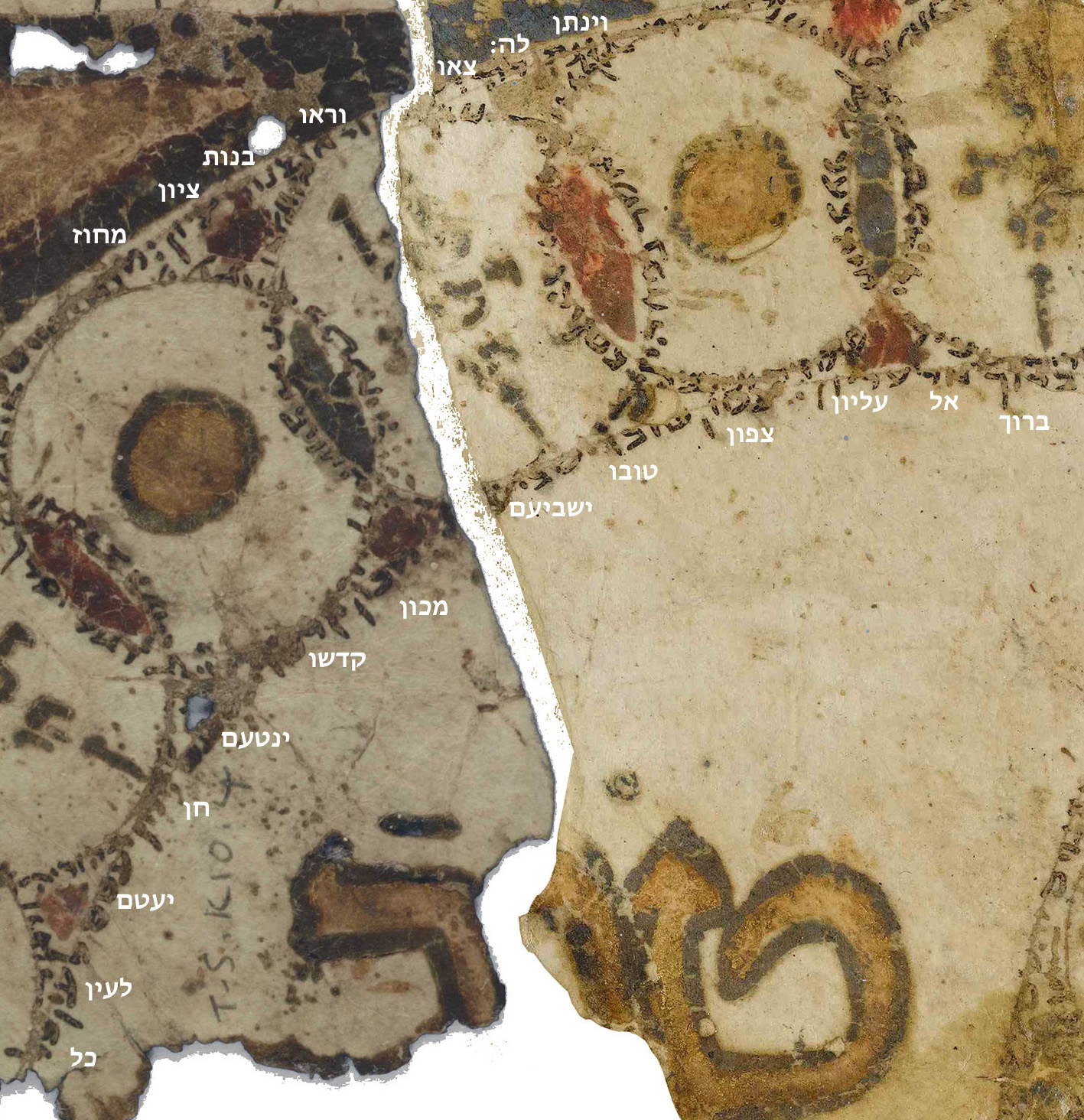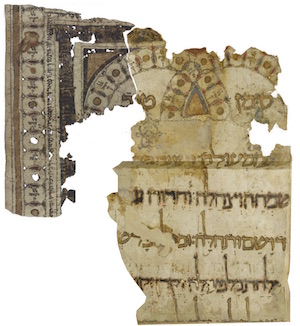Reunited At Last: T-S K10.4 and Bodl. MS. Heb. c. 13/25
Working with the Genizah is sometimes compared to putting together a puzzle with half a million pieces… But it might more accurately be described as putting together half a million different puzzles that have been all jumbled together, and with half the pieces missing. In her award-winning work on the Genizah, Marina Rustow has described the process of finding “joins,” i.e. matches between fragments, as requiring the combination of intuition, training, vision, technology, persistence, and sheer luck.[1]
Through this combination of qualities, mostly the last, I recently came across a join between two well-known fragments which until now have been only studied separately: the fragments T-S K10.4 (in Cambridge) and Bodl. MS. Heb. c. 13/25-28 (in Oxford). The Oxford manuscript has long been recognized by art historians as one of the earliest examples of an illuminated ketubbah.[2] Its arches, formed by interlocking circles of micrography, and its decorations in gold, red, and blue demonstrate a clear artistic relationship between the development of the illuminated ketubbah and the illuminated carpet page of the Masoretic codex, as well as the development of the micrographic tradition itself. Thus, this important fragment was already discussed in early scholarship on the history of the decorated ketubbah, including by Moses Gaster (1923), Rachel Wischnitzer-Bernstein (1932), and Franz Landsberger (1955).[3] Its companion piece in Cambridge, however, languished on the shelf, and at first it was not even catalogued as a ketubbah at all; the handwritten label on its folder in Cambridge still erroneously identifies it as: “Illuminated Fragment — Masoretic Adnotations of an illuminated Bible.”[4]
Cambridge University Library T-S K10.4 (left) joined up with Bodl. MS. Heb. c. 13/25 (right; reproduced by kind permission of the Bodleian Libraries, University of Oxford). Digital image prepared by Aaron Hodge Silver.
By the 1970s, both fragments had been correctly identified as being pieces of an illuminated ketubbah, but separately. In Leila Avrin’s work (both her 1974 dissertation on the Cairo Codex and her 1981 article on Hebrew micrography), she described the Oxford fragment as from a tenth-century ketubbah, and the Cambridge fragment as from a twelfth-century ketubbah.[5] In 1979, Alexander Scheiber argued that the Oxford fragment was in fact also from the twelfth century; he transcribed the large blessing on it, and added that there was another parchment ketubbah fragment “in the same hand” which had not been dealt with, namely the Cambridge fragment, which he went on to describe.[6] He even reproduced plates of both fragments, facing each other! But he apparently did not recognize them as fragments of the same manuscript. Correctly identified, the Cambridge ketubbah fragment has been described in a number of contemporary works on micrography and the history of the ketubbah, such as by Dalia-Ruth Halperin (2008 and 2013), and Shalom Sabar (2000 and 2013), who writes that it is “similar” to the ketubbah fragment in the Bodleian but that its preservation is too poor to be certain, adding in a footnote that “it is possible, however, that this fragment is a Bible page and not a ketubbah.”[7]
However, it can now be shown that not only is this fragment definitively a ketubbah, it is in fact the left side of the ketubbah preserved in Oxford. While preparing a lecture on Hebrew micrography, I looked for an image of a Geniza ketubbah with micrography, and found pictures of both the Oxford and Cambridge ketubbot… Arranging them on the slide, it occurred to me that they were quite similar. In fact, I thought, the designs almost matched up. I inched them closer and closer to each other… Not almost — they did match up perfectly. This was suggested by the join of the large illuminated word tov, and then confirmed on closer inspection thanks to the micrographic decoration (identified by Shulamit Elizur and Sara Cohen as the piyyut Yefefiyya veḥamuda by the eleventh-century poet Yinnon bar Ṣemaḥ), which is continuous from one fragment to the other.
Joining the Cambridge and Oxford fragments, including the pieces that comprise the poetic preamble and text of this ketubbah (Bodl. MS Heb. c. 13/26-28), we can now reconstruct one of the largest illuminated medieval ketubbot from the Genizah. Some portions of other decorated and illuminated ketubbot from this period have been preserved, but because of their fragmentary state they have not yet received extensive scholarly attention.[8] Visualizing the full decorative program of this ketubbah, it must have been incredible: six layers of calligraphic borders of varying widths, including piyyutim in micrography; one thin border of gold outlined in blue; one wide border of gold calligraphy on a blue background; two arches of intersecting circles of micrography interspersed with red, blue, and gold shapes, and the monumental calligraphy of the poetic superscription in gold and blue. As a whole, this ketubbah appears to have been executed to the highest standards of medieval Levantine Jewish book art.

Close up of Cambridge University Library T-S K10.4 (left) joined up with Bodl. MS. Heb. c. 13/25 (right; reproduced by kind permission of the Bodleian Libraries, University of Oxford).
This newly-joined ketubbah is an important example of illumination in the Genizah society, and it demonstrates a clear relationship between the decoration of ketubbot and the carpet pages of Masoretic Bibles. The similarities in the deployment of color and gold, geometric micrography, and architectural layout may in fact suggest that the same artists and illuminators who adorned luxury Bibles like the Leningrad Codex and Cairo Codex were also commissioned for other artistic projects, including ketubbot. The extensive use of liturgical poetry and epithalamia in the micrography, rather than the masoretic commentary used in Bibles, is particularly interesting, both for the textual record of these piyyutim, and for the artistic implications of the development of micrography. In A Mediterranean Society, Goitein observed: “Students of medieval ornamental art have paid little attention to the illuminations of Geniza marriage contracts… Because of the large size of the documents concerned and their fragmentary state any relevant publications will encounter difficulties. But I believe it is an attractive topic.”[9] The reunification of these fragments, and the reconstruction of this magnificent ketubbah, can only render this topic even more attractive for further research.
Footnotes
[1]. See, for example, her keynote lecture “Finding Joins in the Cairo Geniza: Algorithms vs. my Hippocampus,” at the 9th Annual Lawrence J. Schoenberg Symposium on Manuscript Studies in the Digital Age (University of Pennsylvania), November 17-19, 2016, available on YouTube (https://www.youtube.com/watch?v=GvE7ZwWJNXw).
[2]. It is now bound into Bodl. MS. Heb. c. 13: the illuminated heading on folios 25-26, and the ketubbah text for the groom [?] ben David and Sitt al-Sāda bat ‘Adaya on folios 27-28 (this appears to be in the hand of Ḥalfon b. Menasseh or a contemporary). However, this ketubbah text is not continuous with the illumination, and it is not clear whether they can be assumed to be from the same ketubbah.
[3]. Moses Gaster, The Ketubah: A Chapter from the History of the Jewish People (1923), 48 and Plate II; Rachel Wischnitzer, “Schmuck der Ketubba,” Encyclopaedia Judaica: das Judentum in Geschichte und Gegenwart (1932); Franz Landsberger, “Illuminated Marriage Contracts, with Special Reference to the Cincinnati Ketubahs,” Hebrew Union College Annual, Vol. 26 (1955), pp. 505-507.
[4]. This label is cited (and corrected) in Alexander Scheiber, “Zur Geschichte der Proselyten,” Studies in the Bible and Hebrew Language offered to Meir Wallenstein (1979), 68. I thank Dr. Ben Outhwaite for confirming for me that the folder still bears this identification. It appears to be in Goitein’s handwriting.
[5]. Leila Avrin, The Illuminations in the Moshe Ben-Asher Codex (1974), pp. 135, 202, 210, and plates 85 and 99; “Micrography as Art,” La Lettre hébraïque et sa signification (1981), 47.
[6]. Scheiber, “Zur Geschichte der Proselyten,” 68-69, and plates I and II.
[7]. Dalia-Ruth Halperin, “Micrography of Hebrew Script and Art,” Encyclopedia of Hebrew Language and Linguistics (2008), and Illuminating in Micrography: The Catalan Micrography Mahzor—MS Heb 8.6527 in the National Library of Israel (2013), 7-8; Shalom Sabar, Ketubbah: The Art of the Jewish Marriage Contract (2000), pp. 19-20 and 25, and “The Origins of the Decorated Ketubbah in Iran and Afghanistan,” The Jews of Iran: The History, Religion and Culture of a Community in the Islamic World (2013), pp. 115-118.
[8]. See, for some examples, T-S 16.104, T-S 16.73, and T-S 24.17. M.A. Friedman already noted in his comprehensive work on the subject that the Egyptian and Palestinian ketubbot preserved in the Genizah are rarely illuminated, “and the decoration of the ketubba, when it is found, is primarily limited to the superscription of the contract,” Jewish Marriage in Palestine (1980), 96. The joining of these two fragments may now contribute to further research on the extent of ketubbah illumination in the “Classical Genizah period” (ca. 950-1250) and its relation to the development of Jewish book art in the Levant.
[9]. Shlomo Dov Goitein, A Mediterranean Society, Vol. III: The Family (1967), 110.
Cite this article
(2018). Reunited At Last: T-S K10.4 and Bodl. MS. Heb. c. 13/25. [Genizah Research Unit, Fragment of the Month, July 2018]. https://doi.org/10.17863/CAM.34050
If you enjoyed this Fragment of the Month, you can find others here.
Contact us: genizah@lib.cam.ac.uk
The zoomable images are produced using Cloud Zoom, a jQueryimage zoom plugin:
Cloud Zoom, Copyright (c) 2010, R Cecco, www.professorcloud.com
Licensed under the MIT License

